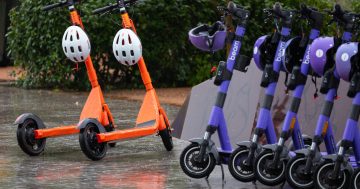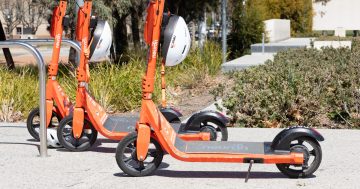
Beam e-scooters lined up at Ainslie Place in Civic. Photo: Photox – Canberra Photography Services.
Electric scooters are a common sight around Canberra’s city and inner suburbs, and with the holiday season upon us, it is timely to remember what is required to avoid breaking the law – and any bones.
Two-wheel e-Scooters offer fun, eco-friendly and convenient transport, however research has found that riders of them sustain more injuries per kilometre than cyclists, and are twice as likely to be injured because of potholes, pavement cracks, lamp posts and sign posts.
Many riders may not be aware of the laws around e-scooter usage for the safety of riders, drivers and pedestrians.
BAL Lawyers special counsel Bill McCarthy says many of the normal road rules apply to e-scooters, such as staying to the left and giving way to pedestrians.
“Like any mode of transport, e-scooters pose a safety risk,” he says. “It is important to understand and follow the road rules that apply to e-scooters, which are different to those for cyclists and drivers.”

Bill McCarthy, from BAL Lawyers, deals with the consequences of unintended accidents and injuries daily. Photo: Michelle Kroll.
Bill says e-scooters are not permitted to be ridden on roads or on-road bicycle lanes, and speed limits apply. Riders on footpaths need to maintain a maximum speed of 15km/h, which increases to 25km/h in all other permitted locations such as bicycle paths and other thoroughfares.
Riders must also slow down to 10km/h when approaching and travelling across a crossing, and ensure they take the shortest and safest route across roads.
“Of course, a properly fitted helmet is essential,” says Bill.
While a regulatory framework is in place for e-scooters, preventing them from being used on ACT roads, ACT Police has reportedly been tolerant with riders as they become accustomed to the rules and regulations. However, this is set to change with a blunt warning being issued in October 2020.
“A tipping point will be if risky behaviour and blatant flouting of the rules leads to incidents that end up in hospital emergency departments,” says Bill.
“I deal with the consequences of accidents and injury on a daily basis. In this case, either party may seek compensation to cover any personal injury and medical expenses or even property repairs resulting from e-scooter accidents.”
He warns that greater responsibility may be borne by the rider, who should ride at a speed and in a manner to avoid an accident with a pedestrian. But it’s not just pedestrians who e-scooter riders need to look out for – they should also watch out to avoid accidental collisions with cars.
“If e-scooters are ridden on the road, which is illegal, riders cause a safety risk to both themselves and drivers on the road,” says Bill. “You don’t need a licence to ride, but road rules such as not carrying a passenger, having a warning device such as a bell, not using mobile phones, and not riding under the influence of drugs or alcohol still apply.”
He says in some countries, e-scooters have been banned on pavements, and riders are required to have a licence.
In Canberra, rented e-scooters can be legally used within set geographical boundaries. Bill says this will probably avoid the incidence of damaged or discarded scooters that beset bicycle share schemes in other cities.
“With Canberra’s well maintained footpaths so suited to the use of e-scooters, the future is looking bright for this transport option,” says Bill.
If you have any questions regarding an accident or injury resulting from the use of e-scooters, contact Bill McCarthy at BAL Lawyers.




















